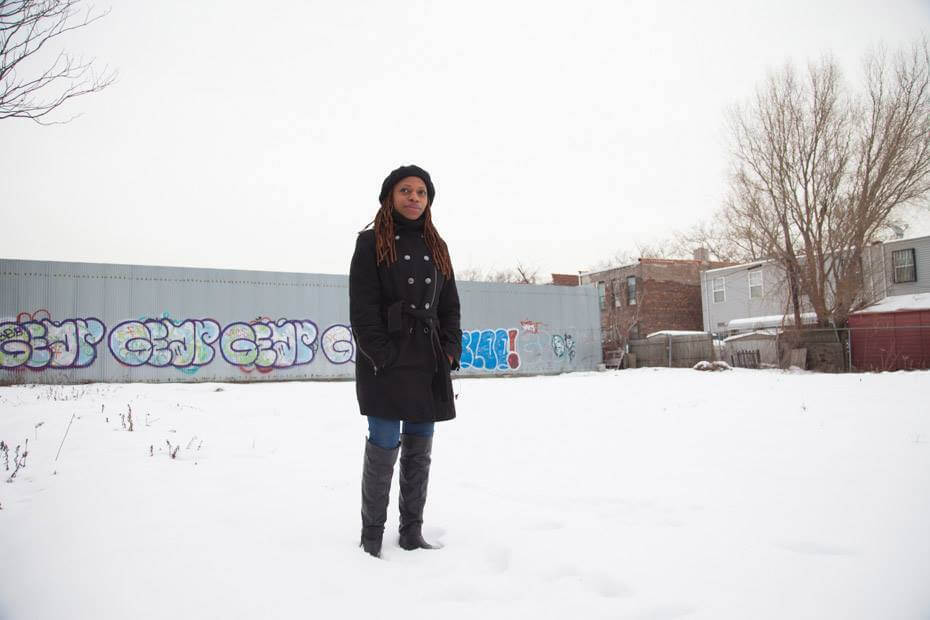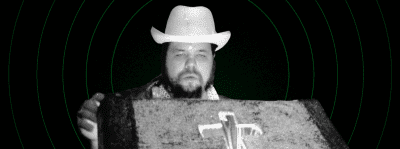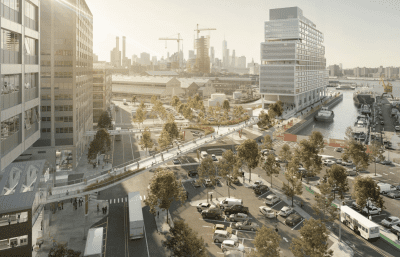Banishing Blight With the Arts in East New York


Catherine Green, Founder and Executive Director of Arts East New York (Photo: Jeyhoun Allebaugh)
East New York has been the topic of a great deal of debate recently—will the blighted, crime-ridden neighborhood be the next real estate hot spot? What kind of impact will the de Blasio administration’s rezoning project have on the area? Could this be the city’s last chance to get it right with affordable housing? Will they succeed?
But in speaking with Catherine Green, Founder and Executive Director of Arts East New York—an organization that supports artists, provides educational opportunities in the arts for local students, and spearheads public art projects—it’s clear that the East New York community is taking an active roll in its own revitalization and transformation in anticipation of change.
Arts East New York started back in 2009, but the organization is about to embark on its most ambitious project to date, [Re]New Lots—transforming a number of vacant lots into creative hubs home to affordable artist studios and small retail spaces for local businesses. “We’re popping up all over East New York,” Green said. “From lot to lot.”
The organization recently received backing from the NYC Economic Development Corporation and other city agencies to begin construction on the first vacant lot chosen by [Re]New Lots located on New Lots Avenue between Van Sinderen and Snediker) an area slated for affordable housing development made made up of mostly African-American homeowners that can be somewhat dark at night.
“We’re creating a cultural infrastructure for this neighborhood and putting another brand on it,” Green said. “Because it does have such a reputation, we’re making sure that change happens over time and we want to support that through the cultural sector.”
Fourteen shipping containers will soon house four artist studios for carefully chosen artists—including Alexis Mena, Sophia Dawson, James Malone, and Thee Art Cave—(the first is from East New York and all are from Brooklyn) as well as ten small businesses. The artists were chosen based from a pool of applicants for the merit of their work and willingness to work closely with the community. In exchange for the below market rate $300 per month studios, the artists will be working with local students on public art projects throughout the community.
Small business owners will also get a chance to rent out spaces at the incubator for $400 a month and will receive on-one-one training and feedback from the Local Development Corporation, one of the city agencies sponsoring the project.
“The goal is to take them from this project, to incubate them and go on and have them flourish,” Green explained. “What’s really incredible is the developer coming in after us is building a 180-room affordable housing unit on the east side of the project and they’re going to have storefront retail on the bottom. That’s the goal. The goal is to get them to the point where we can put them in a brick and mortar building, and not just in this new development but in other places around the community too.”
One area of focus for a public art installation (there will be four throughout the area) is near the Gateway Project. “It’s an old neighborhood but this brand new project is sprouting up as well,” Green explained. “The new homeowners are right across the street from people who have been there for 50, 60 years, so it’s really interesting how that comes to be and what conversations these people are having.” And since community members will be direct participants in the project, “this will be a way for those neighbors to meet one another,” Green said.
The public arts projects that are Arts East New York’s bread and butter don’t just function to connect community members, they also clean up areas that might otherwise be unsafe.
“A lot of the spaces are vacant, or have just been forgotten about, or they’re high crime areas– places the 75th precinct has identified as hot spots, so we intentionally go in and create activity where there was none,” Green said. “Because before it was easy for someone to just get hit over the head.”
In fact one project revamped a garbage strewn lot and turned it into a public park. “It’s funny, my car got stolen there five years before the project,” Green laughed. “That place had been vacant for years and there was all kinds of trash dumped there and how the kids built out the park was just beautiful and that activity really brought a whole new face to that area.”
The fact that Arts East New York incorporates the concerns of the community into their public arts projects– through murals depicting community concerns and the people who live and work there—offers a sharp contrast to how another Brooklyn neighborhood transformed into a creative hub. Things proceeded very differently in Bushwick, where long-time residents have either been displaced by artists moving into the neighborhood or have reacted against the influx of public art work created not by residents or necessarily for residents, but on top of residents.
Organizations like the Bushwick Collective, for example, invited international street artists in to beautify the neighborhood and instead of incorporating what can often be very political concerns of the residents, effectively banned politics from the street art conversation. Though well-intentioned and ultimately attractive (depending on your tastes), the Bushwick Collective effectively coated the neighborhood in vapid imagery that has little to do with the concerns of Bushwick residents.
“We don’t just do art for the sake of art,” Green said. “Whether it addresses community life issues like violence and safety, health disparities– whatever we do, we do it with a clear intention to improve the circumstances of this neighborhood. For the residents who live here, in this neighborhood, our mission is very clear.”
Starting in early April, the [Re]New Lots incubator will open up to the public every day, and on the weekends there will be events including performances by local musicians, film screenings, panel discussions, and dance parties. Green is even courting Borough Hall to set up a trolley connecting Downtown Brooklyn with the incubator on market days to encourage tourists and people living elsewhere throughout the city to check out the neighborhood and bring traffic to the project.
Green envisions this project happening again and again each year after the incubators pack up in October and a new round of applicants will vie for a spot at the next pop-up space. But does Arts East New York anticipate more artists moving to the neighborhood? Could East New York ever be a studio hub?
“Part of the organization’s goal is to do affordable housing for artists,” Green explained, hinting toward the de Blasio administration’s new plans for setting aside 1500 affordable live-work units specifically for artists. “We want them to have a presence in the neighborhood but also being a very integral part of the neighborhood.”
Green pointed to one of the artists selected for the project, Alexis Mena who already helped create a mural in the neighborhood by working with students and local community gardeners.
“He and the kids met with every last gardener and made sure who they were, so these kids walked away with knowledge of these residents they would have never known and depicted them on that mural,” Green explained. “So now it means something, it’s not just painting faces. You know these people, you actually sat down and had dinner with them, if you are fully engaged in your neighborhood, you are invested. Even if you go away to college, do whatever you’re going to do, you’re going to come back to this neighborhood and do the same for the youth here.”
She added: “We make sure we do whatever we do for this community.”
You might also like 




















